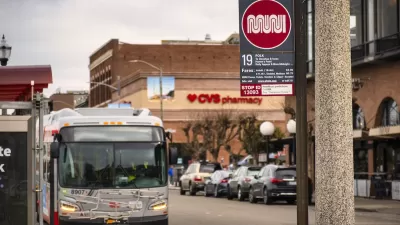The SFMTA is considering a "high-access network" that would let people reach more destinations and increase frequency on some Muni lines.

As part of Jarrett Walker + Associates' work with the San Francisco Municipal Transportation Agency (SFMTA) on its post-pandemic bus service, Jarrett Walker asks, "[w]hen a transit agency comes back from the COVID-19 crisis, should it aim to put service back the way it was, or try to put back something better?"
While Muni has historically served workers commuting into downtown San Francisco, "the pandemic accelerated ongoing trends that have shifted travel patterns away from a single focus on downtown and towards many locations across the city." This summer, SFMTA will present three options to the public to collect feedback and "help the SFMTA Board determine the pattern of Muni service to be implemented in early 2022." The options are:
- Return the Familiar Network
- Build a High-Access Network
- Develop a Hybrid Network, balancing the best features of the first two.
"The High-Access approach would shift some patterns of service to expand people’s ability to get to more destinations sooner," shifting the focus to potentially needed trips that don't exist yet. Because "[b]etter access can mean more opportunities in your life," Walker writes, "[a] high-access network tries to give people as many options as possible."
Regardless of public feedback, "the SFMTA faces severe resource constraints" that will make it difficult to restore pre-pandemic service levels. "It still faces a labor shortage and has lost much of its income from fares and parking revenues, not to mention the structural deficit that existed even before the pandemic." To Walker, "it makes sense to offer only a level of Muni service that the SFMTA is sure they can sustain, at least until they find new resources to replace funds that have eroded over the last decade and fallen dramatically during the COVID-19 pandemic."
FULL STORY: San Francisco: Go Forward by Going Back?

Alabama: Trump Terminates Settlements for Black Communities Harmed By Raw Sewage
Trump deemed the landmark civil rights agreement “illegal DEI and environmental justice policy.”

Study: Maui’s Plan to Convert Vacation Rentals to Long-Term Housing Could Cause Nearly $1 Billion Economic Loss
The plan would reduce visitor accommodation by 25% resulting in 1,900 jobs lost.

Why Should We Subsidize Public Transportation?
Many public transit agencies face financial stress due to rising costs, declining fare revenue, and declining subsidies. Transit advocates must provide a strong business case for increasing public transit funding.

Paris Bike Boom Leads to Steep Drop in Air Pollution
The French city’s air quality has improved dramatically in the past 20 years, coinciding with a growth in cycling.

Why Housing Costs More to Build in California Than in Texas
Hard costs like labor and materials combined with ‘soft’ costs such as permitting make building in the San Francisco Bay Area almost three times as costly as in Texas cities.

San Diego County Sees a Rise in Urban Coyotes
San Diego County experiences a rise in urban coyotes, as sightings become prevalent throughout its urban neighbourhoods and surrounding areas.
Urban Design for Planners 1: Software Tools
This six-course series explores essential urban design concepts using open source software and equips planners with the tools they need to participate fully in the urban design process.
Planning for Universal Design
Learn the tools for implementing Universal Design in planning regulations.
Smith Gee Studio
Alamo Area Metropolitan Planning Organization
City of Santa Clarita
Institute for Housing and Urban Development Studies (IHS)
City of Grandview
Harvard GSD Executive Education
Toledo-Lucas County Plan Commissions
Salt Lake City
NYU Wagner Graduate School of Public Service





























